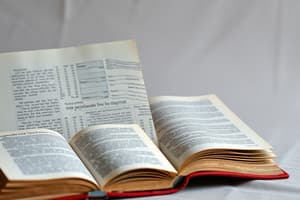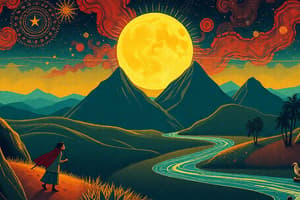Podcast
Questions and Answers
What characterizes primary sources of information?
What characterizes primary sources of information?
- They are interpretations based on secondary data.
- They are created by observers of an event.
- They provide an overview of a topic.
- They are original, uninterpreted materials. (correct)
Which of the following is an example of secondary sources?
Which of the following is an example of secondary sources?
- A government report published after an investigation.
- An academic journal article analyzing a historical event. (correct)
- A diary written during a significant event.
- A novel about a historical period.
What type of media is characterized as 'produced and circulated by indigenous people'?
What type of media is characterized as 'produced and circulated by indigenous people'?
- Indigenous Media (correct)
- Secondary Media
- Commercial Media
- Tertiary Media
What is a riddle primarily designed to test?
What is a riddle primarily designed to test?
Which of the following is a long narrative based on tradition and social values?
Which of the following is a long narrative based on tradition and social values?
The performance known as panunuluyan is typically organized during which occasion?
The performance known as panunuluyan is typically organized during which occasion?
Which form of media involves a theatrical presentation of the passion and death of Jesus Christ?
Which form of media involves a theatrical presentation of the passion and death of Jesus Christ?
What distinguishes tertiary sources from primary and secondary sources?
What distinguishes tertiary sources from primary and secondary sources?
Flashcards
Primary Source
Primary Source
Original, uninterpreted information used as a basis for research.
Secondary Source
Secondary Source
Information created by someone not directly involved in the research topic.
Tertiary Source
Tertiary Source
Provides an overview, basic terminology, and references for a topic.
Indigenous Media
Indigenous Media
Signup and view all the flashcards
Proverb
Proverb
Signup and view all the flashcards
Tanaga
Tanaga
Signup and view all the flashcards
Folk Epic
Folk Epic
Signup and view all the flashcards
Pasyon
Pasyon
Signup and view all the flashcards
Study Notes
Sources of Media and Information
- Primary sources are original, uninterpreted, or "first-hand" materials forming the basis for research studies.
- Secondary sources are created by individuals lacking firsthand experience or participation in events.
- Tertiary sources provide a general overview, basic terminology, and further reading recommendations for a subject.
Sources of Information
- Newspapers
- Magazines
- Academic journals
- Books
- Almanacs
- Websites
- Databases
- Library catalogs
- Encyclopedias
Media and Information Resources
- Indigenous media encompasses various forms of expression, developed, produced, and circulated by indigenous people globally.
Examples of Indigenous Media
- Riddles: Intellectual tests requiring identifying literally described objects.
- Proverbs: Statements describing situations, providing guidance on daily issues.
- Tanaga: Short poems using metaphors to establish analogies between experiences and man's environment.
- Folk Epics: Long narratives based on traditions, values, and customs.
Duplo
- Introduced during the Pre-Spanish era, associated with morning rituals and harvest celebrations.
- Karagatan participants are typically skilled performers, acting as guests to extemporize verses.
Panunuluyan
- Usually performed on Christmas Eve before midnight mass.
- Organized by local town schools or parishes, often a significant community event.
- Tibag is a popular indigenous media form referencing the excavation of mounds during the search for a cross's placement.
Pasyon
- Significant Lenten activity aimed at purifying the soul.
Cenaculo
- Theatrical presentation showcasing Jesus Christ's passion and death.
- Often seen as a stage adaptation of the Pasyon.
Awit
- Equivalent to a metrical romance, usually depicting love between Moro warriors or princes and Christian women.
- Carillo, similar to forms in China and Japan, involves skilled figure manipulation.
Moro-Moro and Comedia
- Theatrical presentations intended to convert native populations to Christianity.
- Utilized by priests who authored plays for these purposes.
Library
- A building or room housing literary, artistic, and reference materials for use only not for sale.
4 Major Types of Libraries
- Academic Library: Serves colleges and universities.
- Public Library: Serves local towns and cities of all types.
- School Library: Serves students from kindergarten to grade 12.
- Special Library: For specialized settings like hospitals, corporations, museums, military, private businesses, and governments.
Internet
- A global network enabling diverse information and communication services.
- Consists of interconnected networks utilizing standardized communication protocols.
Evaluating Information Found on the Internet
- Authorship
- Publishing body
- Accuracy and verifiability
- Currency
Things to Consider in Evaluating Information
- Reliability
- Accuracy
- Value
- Authority
- Timeliness
Reliability of Information
- Information is reliable when it can be verified and evaluated, often examining the source's trustworthiness.
Accuracy of Information
- Accuracy pertains to the closeness of a report to actual data; the accuracy method varies depending on the type of information.
- Forecasts: Alignment with actual data.
- Financial: Correct values.
Value of Information
- Information is valuable when assisting users in decision-making or improvement.
Authority of the Source
- Assessing authorship and credibility of the information source.
Timeliness
- Reliability, accuracy, and value might differ based on when the information was created or accessed as it may become obsolete or irrelevant.
- Timeless information remains consistent in reliability, accuracy, and value throughout history.
Skills in Determining Reliability of Information
- Check the author
- Date of publication/updates
- Citations
- Domain (.com, .edu, .mil, .gov, .org)
Skills in Determining Accurate Information
- Look for facts
- Cross-reference with other sources
- Reasons for the information's creation and publication
Studying That Suits You
Use AI to generate personalized quizzes and flashcards to suit your learning preferences.




